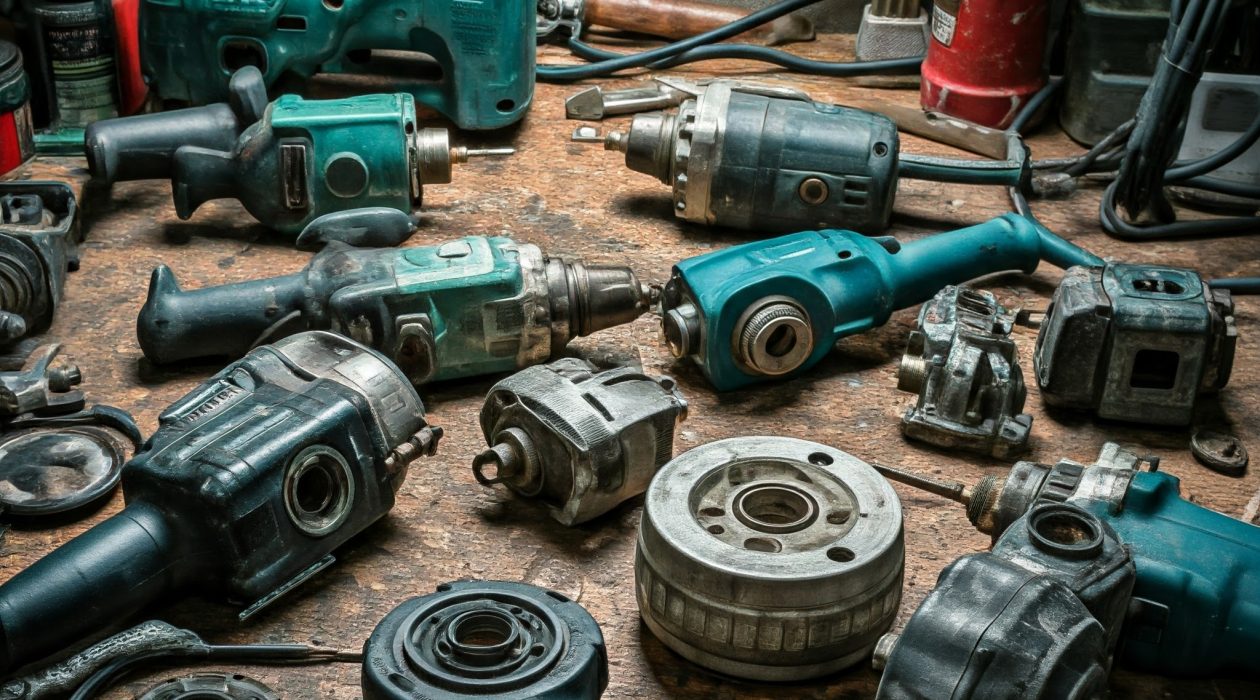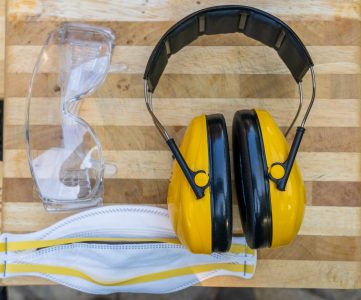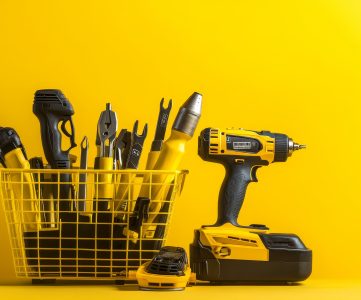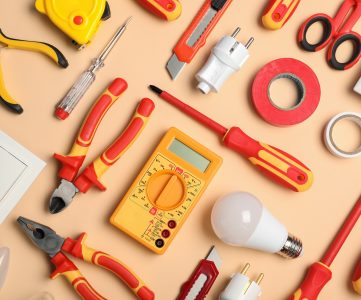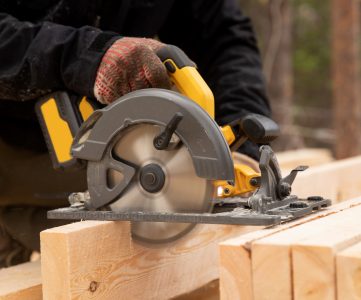Power tools are vital for many tasks, but neglect can turn them into broken tools. Regular maintenance extends their life and prevents accidents. Signs like unusual noises, reduced performance, and visible damage indicate a tool needs fixing or replacing.
Ignoring these signs can escalate damage, making repairs more complex and expensive. It’s vital to address these issues quickly. This ensures your tools work efficiently and safely. By spotting broken tool signs early, you can repair or replace them, reducing downtime and keeping productivity high.
Key Takeaways
- Regular tool repair can help extend the life of your power tools
- Unusual noises, reduced performance, and visual damage are common signs of a broken tool
- Ignoring these signs can lead to further damage and increased costs
- Promptly addressing these issues can ensure your power tools function efficiently and safely
- Recognizing the signs of a broken tool can help minimize downtime and maintain productivity
- Tool repair or replacement is essential for preventing accidents and ensuring safe operation
Warning Signs of Power Tool Malfunction
Using power tools requires awareness of malfunction signs. Repair power tools quickly to avoid further damage and ensure safety. Unusual noises and vibrations are key indicators of a malfunction. These could signal issues with the motor or gearbox.
Reduced performance and power are also warning signs. If your tool isn’t working as fast or efficiently, it might have electrical or mechanical problems. Fixing tools quickly can prevent more damage and reduce injury risks.
Common Malfunction Signs
- Unusual noises and vibrations
- Reduced performance and power
- Visual damage indicators, such as cracks or breaks in the tool’s housing
Addressing these issues promptly is crucial for safety and to prevent further damage. Regular maintenance and inspections can catch problems early. Being aware of malfunction signs and acting fast to repair power tools can extend their life and prevent accidents.
Preventative Measures
Regular maintenance is essential to prevent malfunctions. Check the electrical system, lubricate moving parts, and inspect the housing for damage. These steps can reduce malfunction risks and ensure your tools operate safely and efficiently.
Common Electrical Issues in Power Tools
Identifying the cause of broken tools is crucial. Electrical problems in power tools are common and can be dangerous. Tool repair specialists often find issues with cords, switches, and motors.
Begin by examining the power tool’s cord and plug for damage. Look for frayed cords, loose connections, or damaged prongs. If you spot any problems, it’s wise to replace the cord or plug to avoid further damage.
A faulty switch is another frequent issue. If the switch is damaged, it might not allow the tool to turn on or off. In such cases, you might need to replace the switch or seek professional help. Regular tool repair and upkeep can prevent these problems and keep your tools safe and efficient.
Some common electrical problems in power tools include:
- Malfunctioning motors
- Failed capacitors
- Short circuits
Preventing electrical issues in power tools requires regular maintenance and inspections. By regularly checking your tools and fixing any problems quickly, you can lower the risk of broken tools. This ensures your power tools operate safely and efficiently.
Understanding Mechanical Wear and Tear
Using power tools regularly can cause mechanical wear and tear. This may necessitate repair power tools to keep them working well and lasting longer. Issues can stem from different parts, like motors, gear systems, and chuck and bit holders. Spotting these problems early can stop further damage and cut down on expensive fixes.
Signs of mechanical wear include odd noises, vibrations, and less performance. To tackle these, understanding the causes and fixes is crucial. For example, motor troubles can be fixed by fixing tools like swapping out old brushes or cleaning the motor. Gear system failures might need more serious repairs, like replacing broken gears or bearings.
Mechanical Issues and Solutions
- Motor problems: replacing worn-out brushes, cleaning the motor housing
- Gear system failures: replacing damaged gears, bearings, or lubricating the system
- Chuck and bit holder issues: replacing worn-out chuck jaws, cleaning the bit holder
Preventive maintenance is vital to reduce mechanical wear and tear. Regular checks and cleanings of power tools can spot issues before they grow. By fixing these problems quickly and repairing power tools when needed, users can keep their tools running smoothly and safely.
When Professional Tool Repair Makes Sense
Dealing with broken tools can be frustrating, affecting your work or projects. Deciding whether to repair or replace tools is challenging. Professional tool repair services offer a viable option, but it’s crucial to weigh costs and benefits before deciding.
A cost-benefit analysis is key in deciding between repair or replacement. Compare the cost of repair to the cost of a new tool. If repair costs are lower, it might be more economical. Also, if your tool is still under warranty, check if the manufacturer will cover repair costs.
Cost-Benefit Analysis
- Assess the cost of repair versus replacement
- Consider the tool’s age and condition
- Evaluate the cost of new parts or components
Warranty Considerations
Review your tool’s warranty to see if it covers repairs or replacements. Some manufacturers offer extended warranties or maintenance plans to reduce repair costs. Always follow the manufacturer’s guidelines for maintenance and repair to keep your warranty valid.
By considering these factors, you can make an informed decision about whether to opt for professional tool repair or replacement. Remember to prioritize your safety and the safety of others when dealing with broken tools. If unsure about the best course of action, don’t hesitate to seek professional help.
| Tool Type | Repair Cost | Replacement Cost |
|---|---|---|
| Drill | $50-$100 | $100-$200 |
| Saw | $70-$150 | $150-$300 |
| Sander | $30-$80 | $80-$150 |
Safety Risks of Damaged Power Tools
Using damaged power tools can lead to serious safety issues, including electrical shock, injuries from debris, and fires. It’s crucial to fix these tools quickly to prevent accidents and maintain a safe workspace. Repair power tools immediately to avoid any potential dangers.
Some common safety risks from damaged power tools include:
- Electrical shock from faulty wiring or damaged cords
- Injury from flying debris, such as broken blades or shattered glass
- Fire from overheated motors or sparks igniting flammable materials
Regular maintenance and fixing tools can prevent these risks. It’s vital to check power tools regularly for damage or wear. By proactively maintaining and repairing tools, individuals can ensure a safe work environment and avoid accidents.
Remember, safety is paramount when using power tools. Being aware of potential risks and taking steps to mitigate them ensures a safe and healthy workspace. Regular repair power tools and maintenance prevent accidents and keep tools safe and efficient.
| Safety Risk | Prevention Method |
|---|---|
| Electrical Shock | Regularly inspect cords and wiring for damage |
| Injury from Flying Debris | Wear protective gear, such as safety glasses and gloves |
| Fire | Keep flammable materials away from power tools and ensure proper ventilation |
DIY Tool Repair: What You Can Fix at Home
Knowing when to tackle DIY tool repair versus when to call a professional is crucial. Many common issues can be resolved at home with basic maintenance and simple repairs. Regular upkeep prevents the need for repairs and keeps your power tools running smoothly.
Basic maintenance includes cleaning and lubricating parts, inspecting for wear, and proper storage. Simple fixes, like replacing cords or switches, can be done with the right tools and knowledge. Yet, it’s vital to recognize when to seek professional help to avoid further damage or safety hazards.
Basic Maintenance Steps
- Regularly clean and lubricate moving parts to reduce friction and wear
- Check for worn-out components, such as brushes or bearings, and replace them as needed
- Store tools in a dry, secure location to prevent damage and rust
Simple Repairs Anyone Can Do
Replacing a faulty cord or switch is a simple task that can be done at home. It’s important to follow safety guidelines and manufacturer instructions. If unsure about any repair, it’s wise to seek professional help to prevent further damage or safety risks.
When to Stop and Seek Help
For complex issues like motor problems or gear system failures, professional help is best. They have the expertise and tools to diagnose and fix problems efficiently and safely. If you’re unsure or uncomfortable with a repair, it’s safer to seek professional assistance to avoid further damage or safety risks.
| Tool Type | Common Issues | Repair Difficulty |
|---|---|---|
| Drill | Broken chuck, faulty switch | Easy to moderate |
| Saw | Blade damage, motor problems | Moderate to difficult |
| Sander | Worn-out belt, faulty motor | Easy to moderate |
Finding Reliable Tool Repair Services Near You
When your power tools need repair, finding a reliable service is crucial. Start by asking friends, family, or colleagues for recommendations on repair power tools. Online reviews from trusted sources can also provide insights into the service’s quality and customer satisfaction.
A trustworthy tool repair service should have skilled technicians. They should be adept at fixing tools from various brands. Look for a service that offers a warranty and uses genuine parts. Key factors to consider include:
- Experience and expertise in repairing power tools
- Quality of work and customer satisfaction ratings
- Warranty and guarantee policies
- Use of genuine parts and materials
Researching and evaluating potential services based on these criteria will help you find a reliable provider. Prioritize quality and reliability when repairing power tools and fixing tools. This ensures your tools operate safely and efficiently.
Consider the cost of repair versus replacement when deciding. A reliable service can guide you in making an informed decision. They will offer the best options for your situation.
| Factor | Importance | Description |
|---|---|---|
| Experience | High | The repair service should have experience in fixing various types of power tools. |
| Quality of work | High | The repair service should provide high-quality work and ensure that your tools are restored to their original condition. |
| Warranty | Medium | The repair service should provide a warranty for their work to ensure that you are protected in case something goes wrong. |
Replacement vs. Repair: Making the Right Choice
When dealing with broken tools, it’s essential to weigh the pros and cons of replacement vs. repair. Tool repair can be a cost-effective option, but it’s crucial to consider the age and condition of the tool. If the tool is old and has undergone significant wear and tear, replacement might be the better choice.
A key factor to consider is the cost comparison between repair and replacement. Here are some guidelines to keep in mind:
- Assess the cost of repair: If the repair cost exceeds 50% of the tool’s original price, it might be more economical to replace it.
- Consider the tool’s lifespan: If the tool is nearing the end of its expected lifespan, replacement might be a better option.
- Evaluate the tool’s performance: If the tool’s performance is significantly impacted by the damage, replacement might be necessary to ensure optimal functionality.
It’s also important to consider technology updates when deciding between replacement and repair. Newer tools may offer improved features, increased efficiency, and enhanced safety.
In conclusion, the decision to replace or repair broken tools depends on various factors, including the tool’s age, condition, and performance. By considering these factors and weighing the pros and cons, you can make an informed decision that suits your needs and budget. Remember to always prioritize tool repair and maintenance to extend the lifespan of your tools and ensure optimal performance.
| Factor | Replacement | Repair |
|---|---|---|
| Cost | Higher upfront cost | Lower upfront cost |
| Lifespan | New tool with full lifespan | Extended lifespan of existing tool |
| Performance | Optimal performance with new tool | Restored performance with repair |
Maintaining Tool Performance and Safety
Throughout this article, we’ve highlighted the importance of maintaining and repairing your power tools. This ensures they perform reliably and last longer. By recognizing warning signs of malfunctions and addressing common issues, you can keep your tools in excellent condition. This approach also promotes safe working practices.
Time and resources invested in tool maintenance boost productivity and work quality. Simple tasks like cleaning, lubrication, and minor adjustments can greatly improve performance. For more complex problems, seeking professional help can prevent the need for early replacement, saving you money.
Your safety is paramount when using power tools. Neglecting signs of wear or damage can result in severe accidents. It’s vital to address any issues promptly to ensure your safety and that of others. By adhering to the advice in this article, you can maintain your tools effectively. This will allow you to work safely and efficiently in your workshop.
